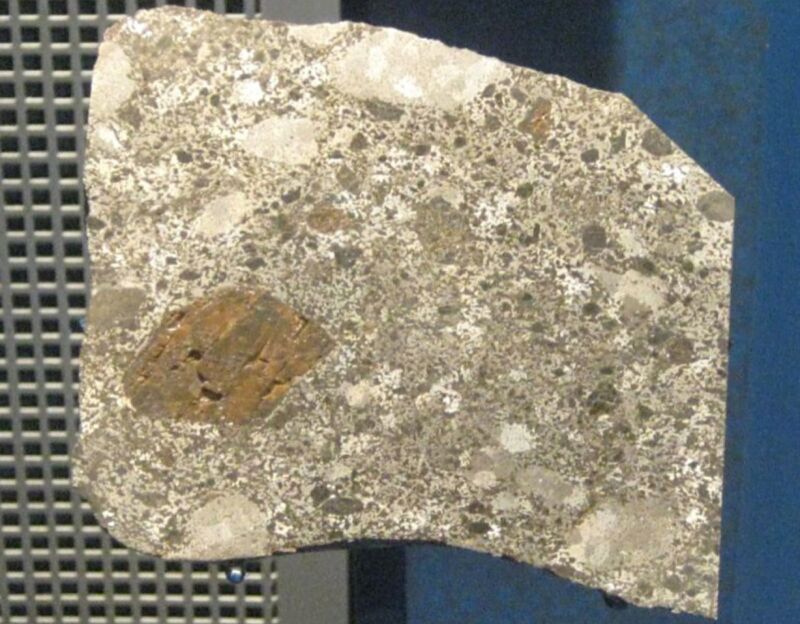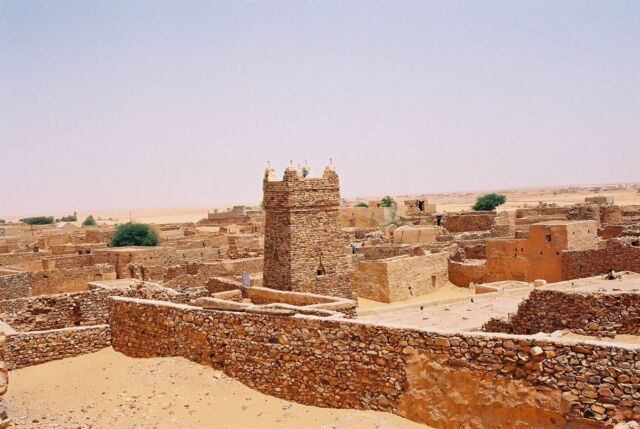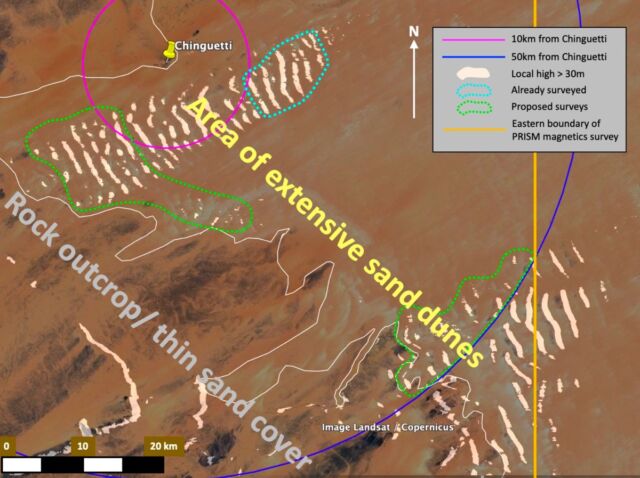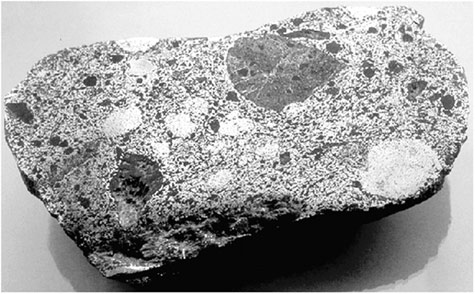
Chinguetti slice at the National Museum of Natural History. A larger meteorite reported in 1916 hasn't been spotted since.
Claire H./CC BY-SA 2.0
In 1916, a French consular official reported finding a giant "iron hill" deep in the Sahara desert, roughly 45 kilometers (28 miles) from Chinguetti, Mauritania—purportedly a meteorite (technically a mesosiderite) some 40 meters (130 feet) tall and 100 meters (330 feet) long. He brought back a small fragment, but the meteorite hasn't been found again since, despite the efforts of multiple expeditions, calling its very existence into question.
Three British researchers have conducted their own analysis and proposed a means of determining once and for all whether the Chinguetti meteorite really exists, detailing their findings in a new preprint posted to the physics arXiv. They contend that they have narrowed down the likely locations where the meteorite might be buried under high sand dunes and are currently awaiting access to data from a magnetometer survey of the region in hopes of either finding the mysterious missing meteorite or confirming that it likely never existed.
Captain Gaston Ripert was in charge of the Chinguetti camel corps. One day he overheard a conversation among the chameliers (camel drivers) about an unusual iron hill in the desert. He convinced a local chief to guide him there one night, taking Ripert on a 10-hour camel ride along a "disorienting" route, making a few detours along the way. He may even have been literally blindfolded, depending on how one interprets the French phrase en aveugle, which can mean either "blind" (i.e. without a compass) or "blindfolded." The 4-kilogram fragment Ripert collected was later analyzed by noted geologist Alfred Lacroix, who considered it a significant discovery. But when others failed to locate the larger Chinguetti meteorite, people started to doubt Ripert's story.
"I know that the general opinion is that the stone does not exist; that to some, I am purely and simply an imposter who picked up a metallic specimen," Ripert wrote to French naturalist Theodore Monod in 1934. "That to others, I am a simpleton who mistook a sandstone outcrop for an enormous meteorite. I shall do nothing to disabuse them, I know only what I saw."
Encouraged by a separate report of local blacksmiths claiming to recover iron from a giant block somewhere east or southeast of Chinguetti, Monod intermittently searched for the meteorite several times over the ensuing decades, to no avail. A pilot named Jacques Gallouédec thought he spotted a dark silhouette in the Saharan dunes in the 1980s. But neither Monod nor a second expedition in the late 1990s—documented by the UK's Channel 4—could find anything. Monod concluded in 1989 that Ripert had likely mistakenly identified a sedimentary rock "with no trace of metal" as a meteorite.
Still, as Rutgers University physicist Matt Buckley noted on Bluesky, "This story has everything: giant unexplained meteorites, sand dunes, a guy named Gaston, ductile nickel needles, secret aeromagnetic surveys, and camel drivers." So naturally, it intrigued Stephen Warren of Imperial College London, Oxford University's Ekaterini Protopapa, and Robert Warren, who began their own search for the mysterious missing meteorite in 2020.

Old town, Chinguetti, in Mauritania, the nearest city to where Gaston Ripert claimed to have f
ound a giant meteorite in 1916.
François Colin/CC BY-SA 2.5
The trio acknowledges that there are reasonable pro and con arguments for the existence (or not) of the Chinguetti meteorite. On the con side, there is no evidence of an impact crater, although a 1951 study suggested this could be explained if the meteorite's flight path had been nearly tangential to the Earth's surface. The strongest evidence against its existence comes from a 2001 analysis of radionuclide data for the small sample Ripert brought back. That data showed that the fragment's parent could not have been more than 1.6 meters in diameter, and the 2001 authors suggested that Ripert was either mistaken or outright lied.
But a Marseille astronomer named Jean Bosler had spoken to Ripert at length about the latter's discovery and believed the man to be sincere. One detail in particular is strikingly credible: Ripert described finding "metallic needles" in one area of the meteorite that he tried to break off by hitting it with the fragment. The needles proved too ductile. In 2003, scientists discovered that iron meteorites often do indeed contain nickel-rich spikes that are similarly ductile. There is no way Ripert (or any contemporary scientist) would have known about that in 1916.
Warren et al. have their own hypothesis. "It is possible that the meteorite became covered by sand within a few years [of Ripert's discovery]," they wrote. "And because the initial searches were in the wrong direction, it is conceivable that the meteorite was missed and remains hidden in the high dunes, still waiting to be discovered." As for the unusual feature spotted by Gallouédec in the 1980s, it was probably a shale diapir, "an ephemeral phenomenon which we have observed a number of times in the area," they wrote. "These blocky dark masses stand out strikingly, silhouetted against the light-colored dunes, and are hard to fathom until seen up close."
If the Chinguetti meteorite is indeed buried in a sand dune, Warren et al. estimated that such a dune would need to be at least 40 meters high (the estimated height of the missing meteorite) and used digital elevation model (DEM) data to identify likely locations. This included determining how fast the dunes migrated; they estimated that the dunes could not have moved more than 100 meters (about 328 feet, or 0.6 miles) since 1916. They identified two areas of high dunes near Chinguetti: Les Boucles, some 20 kilometers (12.5 miles) to the south; and the Batraz region between 40-60 kilometers (25-37 miles) to the southeast. "There is nowhere else for the meteorite to hide," they argued.

Map showing the high sand dunes to the south of Chinguetti.
R. Warren et al., 2024
That led them to the question of just how far a camel could reasonably travel over that terrain in 10 hours, both with and without burdens. (Insert your own Monty Python jokes about the airspeed velocity of an unladen African or European swallow here.) Our intrepid authors made two excursions riding camels in the area and found that burdened camels averaged daily speeds of 2.6 to 3.9 km/hr (1.6 to 2.4 mph). Unburdened camels averaged 5 km/hr (3.1 mph). Ripert and his guide probably rode largely unburdened camels, per Warren et al., who thought the faster speed would not be reasonable across less smooth terrain—plus Ripert and his guide likely would have stopped to rest along the way rather than riding for 10 straight hours.
Indeed, the chameliers who guided the authors on their two excursions said they never traveled more than four hours at a stretch before taking a three-hour break so the animals could recover. Nor would the journey have been made in a straight line, particularly at night. So the authors concluded that there was an upper limit of 50 kilometers (31 miles) and a lower limit of 10 kilometers (6.2 miles) from Chingiuetti since "one would think that [Ripert] would have recognized the dunes close to town."
What's needed now is a magnetometer survey over the region the authors have identified as being the most likely location of the Chinguetti meteorite, if it exists. (The 1990s expedition had a magnetometer but only took a few null measurements at the location identified by Gallouédec.) The good news is that there is such an aeromagnetic dataset already, collected as part of a project called PRISM-1. It's currently held by the Mauritanian Ministry of Petroleum Energy and Mines. The bad news is that the data and detailed maps are proprietary information, and while Warren et al. have made repeated requests, they have yet to gain access.
Alternatively, one could conduct a surface magnetometer survey on foot along the Western base of each potential dune. In December 2022, the authors did just that, focusing on a small area covering six dunes. They were able to rule out all six. To complete a full survey of the areas of interest, they estimate it would take at least three weeks. It would be much easier to analyze the PRISM-1 data, should the team be granted access.
"[E]xamination of the PRISM-I aeromagnetics data in the region south of Chinguetti... can finally resolve the question of the existence of the Chinguetti meteorite in a definitive manner," Warren et al. concluded. "If the result is negative the explanation of Ripert’s story would remain unsolved, however, and the problems of the ductile needles, and the coincidental discovery of the mesosiderite would remain."
arXiv, 2024. DOI: 10.48550/arXiv.2402.14150 (About DOIs).



3175x175(CURRENT).thumb.jpg.b05acc060982b36f5891ba728e6d953c.jpg)



Recommended Comments
There are no comments to display.
Join the conversation
You can post now and register later. If you have an account, sign in now to post with your account.
Note: Your post will require moderator approval before it will be visible.